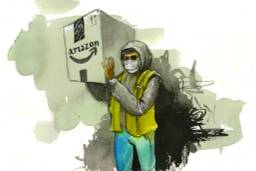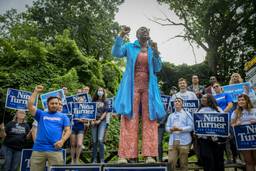Fearing Trump’s New Crackdown, Immigrants Are Already Forgoing Food Stamps
The Trump administration’s new “public charge” rule is having its intended effect: collective punishment of immigrant communities.
Michelle Chen

The Trump administration clarified this week which kind of immigrants it prefers, and which it would rather send back to where they came from. A new rule will give the Department of Homeland Security more authority to deny green cards to immigrants who appear likely to become dependent on government assistance.
The new rule expands an arcane law on “public charges,” a label used by the U.S. government to assess whether green card or visa applicants are likely to be “self-sufficient.” Under the longstanding law, that information can, in turn, be used to deny green cards to immigrants. On Tuesday, Ken Cuccinelli, the acting director of U.S. Citizenship and Immigration Services, quipped on NPR of the new rule, “Give me your tired and your poor who can stand on their own two feet and who will not become a public charge,” changing the lines of the famous poem emblazoned on the Statue of Liberty.
The underlying purpose of the new rule, however, is not fiscal prudence but collective punishment.
The new rule dramatically broadens the scope of the “likely to become a public charge” category, and expands the criteria to include programs such as food stamps, Medicaid and federal housing benefits like Section 8 rent subsidies. The government will also now take into consideration applicants’ health and financial background: Living in poverty counts against you, but an income of at least 250 percent above the poverty level could boost your chances.
Since first proposed last year, the rule has drawn more than 260,000 public comments, which have been overwhelmingly negative. It now faces several legal challenges but is scheduled to go into effect on October 15. The measure, based on a late-19th-century law that barred the admission of “idiots” and “insane persons,” is a relic of an era when medical examiners prodded and daubed arrivals to Ellis Island like cattle.
President Trump’s focus on enforcing new controls on current immigrants marks a pivot in his anti-immigrant agenda, from cracking down on undocumented migrants to establishing a “merit-based” framework that favors wealthier, better educated (and often whiter) newcomers. Earlier this year, the administration moved to make the sponsors of immigrants financially liable for the public benefits immigrants use, and to expel undocumented immigrants from public housing.
Trump’s rule would apply to more than 382,000 noncitizens nationwide. According to the Migration Policy Institute, about 70 percent of people who have recently become permanent residents would meet at least one of the negative criteria in the public charge test. Similarly, the Center on Budget and Policy Priorities estimates that more than half of U.S.-born citizens have used at least one of the listed benefits during their lifetimes. Although DHS would have some discretion over when to label someone as a likely public charge, those who are branded as such could eventually end up on track to deportation — which could result in a greater public cost if a family is left impoverished after the removal of a primary breadwinner.
Even before the rule is enacted, the threat of being branded a likely public charge is already driving immigrants away from public benefits. The Urban Institute estimates that in 2018, one in seven adults in immigrant families “did not apply for or dropped out of” a benefits program, citing “fear of risking future green card status.” The deterrent effect was even more pronounced for immigrants in households with children, Latinx immigrants and those living close to the poverty line.
Trump’s crackdown appears to be prompting many immigrants in New York City to opt-out of nutrition assistance. The New York City Department of Social Services reported a disproportionate decline in food stamps enrollment since Trump took office, and the highest rates of disenrollment in 2018 were seen among black and Latinx noncitizens. This disenrollment — estimated to include 25,000 individuals over two years — is expected to result in a $72 million loss in economic activity for the city. The New York-based nonprofit Robin Hood Foundation has also estimated that the policy change could increase the citywide poverty rate by five percent.
For households already struggling with poverty, giving up a monthly food stamp supplement could push them toward hunger. One immigrant interviewee told Urban Institute researchers, “People don’t eat like they used to, because everything is too expensive. Before, people could purchase a greater variety of foods using their food stamps. But because we no longer have that aid, well, you eat what you can.”
Danilo Trisi, a senior research analyst at the Center on Budget and Policy Priorities, noted that some groups are exempt from the public charge test, notably refugees and people with humanitarian visas, but they too may recoil from accessing benefits. “Because immigration rules are complicated and sometimes opaque, many families that [are exempt] may nevertheless choose to forgo benefits for which they qualify, out of fear that their status could otherwise be in jeopardy,” said Trisi.
Veyom Bahl, managing director of the Survival program at the Robin Hood Foundation, says via email, “From both quantitative and anecdotal sources, the chilling effect has already materialized and is likely worsening.” His organization’s food pantries — part of a network of food banks that form an alternative private “safety net” for New Yorkers in need — have also “seen a decline in immigrant families seeking even free, emergency food support in the last year.” With immigrants seemingly wary of receiving any aid, public or private, the Robin Hood Foundation has provided additional funding to local organizations to provide legal guidance for immigrants adapting to the new rule.
In addition to undermining social safety net programs, immigrants might also be deterred from even applying to adjust their status, explained Max Hadler, director of Health Policy with the New York Immigration Coalition. “It’s not just about people using health benefits or food benefits or housing benefits,” Hadler said. “It’s also the degree to which something like this discourages people from submitting applications for green cards and other immigration benefits. And we want to encourage people who have a pathway to permanent residency and citizenship to pursue those pathways.”
Still, community groups are hoping that the lawsuits filed by 13 state attorneys general this week will manage to thwart the rule before October 15. Even if the rule is halted by litigation, however, Hadler said “there’s a lot of damage that’s already been done.”

I hope you found this article important. Before you leave, I want to ask you to consider supporting our work with a donation. In These Times needs readers like you to help sustain our mission. We don’t depend on—or want—corporate advertising or deep-pocketed billionaires to fund our journalism. We’re supported by you, the reader, so we can focus on covering the issues that matter most to the progressive movement without fear or compromise.
Our work isn’t hidden behind a paywall because of people like you who support our journalism. We want to keep it that way. If you value the work we do and the movements we cover, please consider donating to In These Times.
Michelle Chen is a contributing writer at In These Times and The Nation, a contributing editor at Dissent and a co-producer of the “Belabored” podcast. She studies history at the CUNY Graduate Center. She tweets at @meeshellchen.







